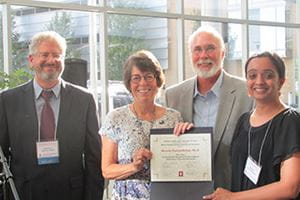Shweta Puntambekar, PhD, often talks with family friends in her home country of India over the phone or on Zoom about Alzheimer’s disease, connecting them with resources for caregivers and explaining some of the ongoing research pertaining to the neurodegenerative disease.
Puntambekar, an assistant research professor in medical and molecular genetics at Indiana University School of Medicine, has only studied Alzheimer’s in the laboratory since 2016, but the disease has unfolded in her family. She lost her grandmother to Alzheimer’s disease a few years ago, and another one of her relatives was diagnosed with early-onset Alzheimer’s.
“Having people in your own family or within your own circle who you see go through this makes it a very personal type of research,” Puntambekar said.
November is National Alzheimer's Disease Awareness Month and National Family Caregivers Month. Nearly 50 million people worldwide, including about 5.8 million in the United States, are estimated to have Alzheimer’s disease or related dementia, according to the World Health Organization. In the U.S., that’s expected to rise to about 14 million people by 2050.
And those caring for the millions of Americans living with the disease spent an estimated 18.5 billion hours helping their loved ones in 2019, according to the Alzheimer’s Association.
Over the past several years, the amount of funding for Alzheimer’s disease research has grown significantly at IU School of Medicine. The school is ranked fifth in the U.S. for funding from the National Institute on Aging, the largest funding branch for Alzheimer’s disease research within the National Institutes of Health (NIH). Many IU investigators who were awarded this funding belong to both Stark Neurosciences Research Institute and the Indiana Alzheimer's Disease Research Center.
In 2019, investigators at Stark Neurosciences Research Institute received $64 million in Alzheimer’s disease research funding, an increase of close to $50 million since 2016. So far in 2020, the neuroscience institute has received $66 million in funding from the National Institutes of Health, with $60 million of that funding through the National Institute on Aging.
We sat down with researchers from four IU School of Medicine laboratories at Stark Neurosciences Research Institute who recently received new NIH funding in 2020.
Shweta Puntambekar
Puntambekar is a co-investigator on a recent $3 million grant from the National Institute on Aging focusing on how microglia—the brain’s immune cells—contribute to neurodegeneration.
The research project, titled “Deciphering the role of CX3CR1 in Modulating Mechanisms of Amyloid driven Neurodegeneration in Alzheimer’s Disease,” is led by principal investigators at IU School of Medicine, Bruce Lamb, PhD and Jason Meyer, PhD. Lamb is the executive director of Stark Neurosciences Research Institute and co-director of the IU Health-IU School of Medicine Neuroscience Institute; he was also recently elected to the Alzheimer’s Association Board of Directors. Meyer is an associate professor of medical and molecular genetics.
Through the grant, researchers will use a well-established mouse model of Alzheimer’s disease, which has substantial amyloid plaque accumulation, and delete CX3CR1, a microglial gene that’s recently been associated with neurodegeneration in Alzheimer’s disease and ALS. The gene variant was first identified and associated with macular degeneration, also a neurodegenerative disease.
Amyloid plaques are commonly found in the brains of patients with Alzheimer’s disease; amyloid beta proteins clump together and form plaques, which destroy nerve cell connections.
Puntambekar said she hopes this research will “push the study of microglia” and look at the whole spectrum of Alzheimer’s disease—how microglia respond to amyloids at the early stages of the disease and how that interaction leads to the loss of neurons, or neurodegeneration.
In addition to mouse models, the researchers will work with Meyer’s laboratory and use human pluripotent stem cells—derived from healthy, non-Alzheimer’s disease patients—to culture neuron cell types and human microglia cell types. They will introduce mutations related to Alzheimer’s disease and the gene they’re studying to the cells using CRISPER-Cas9 technology.
To confirm their findings, Puntambekar said they will repeat the process using cells from Alzheimer’s disease patients.
“The most exciting part of this grant is where we begin with the mouse model but we’re also trying to validate what we see in the mice and see if we can actually start applying these results to human Alzheimer’s disease as well,” Puntambekar said.
When Puntambekar joined the lab at IU School of Medicine in 2016, she wanted to have more access to patient research by studying Alzheimer’s disease and be “part of the solution.”

In 2017, Puntambekar received the first-ever Sarah Roush Memorial Fellowship in Alzheimer’s Disease Research, established by the Indiana Alzheimer's Disease Research Center. It’s funded through a generous donation from James and Nancy Carpenter and a matching contribution from Stark Neurosciences Research Institute.
She also has a passion for caregivers. After Puntambekar came to the United States for graduate school, she would visit her family in India. Her mom was the primary caregiver for Puntambekar’s grandmother, and each visit she noticed her grandmother’s regression in memory, adding that’s it’s tough on caregivers for those suffering from Alzheimer’s disease and dementia to see their loved ones lose memory, personality and independence over time.
Puntambekar said caregivers not only need resources to counseling and mental health assistance, but also for scientists to clearly provide insights into the disease and its research.
“For us as scientists to be able to describe to them what the data says is huge,” she said.
 Cristian Lasagna-Reeves
Cristian Lasagna-Reeves
Over the past 12-plus years, Cristian Lasagna-Reeves, PhD, assistant professor of anatomy, cell biology, and physiology, has been expanding upon an idea to investigate how tau—a protein primarily found in neurons that appears abnormal in the brains of Alzheimer’s disease patients—moves from one neuron to the next through the brain, producing neurodegeneration.
“In animal models it has been observed and described in detail,” Lasagna-Reeves said about tau’s effect on the brain, “but there are two big questions that people don’t know: How does it happen and which one is the tau species that propagates, called the tau-seed.”
The grant Lasagna-Reeves received from the National Institute of Neurological Disorders and Stroke, is called “Tau-seed protein interactome and its role in neurodegenerative tauopathies.”
“This research will allow us to understand the mechanism by how tau aggregates propagate throughout the brain and to identify the specific tau species that propagate acting like a ‘seed’ inducing the aggregation of normal tau,” Lasagna-Reeves said.
Tau needs other proteins to form the seed and propagate, he said. The majority of the study will focus on how a specific protein, called bassoon, interacts with a tau-seed. The protein is essential for tau aggregates to form and then propagate throughout the brain, he said.
Lasagna-Reeves said his laboratory will understand the mechanisms of the protein in tau pathogenesis through animal models; secondly grow primary neurons in cell culture; and lastly use human brain samples of patients of various tauopathies, or neurodegenerative diseases characterized by the accumulation of tau. This includes Alzheimer’s disease, progressive supranuclear palsy (PSP) and Pick’s disease. There are at least 20 tauopathies, he said.
The magnitude of tau’s effect on that many diseases pushed him to focus on the protein. Ever since high school, Lasagna-Reeves said he wanted to research Alzheimer’s disease. And once he started his undergraduate work at the University of Chile, he started focusing on tau, and he continued to through his PhD, postdoctoral training and as a principal investigator.
Tau accumulates differently in each type of tauopathy and proteins that interact with tau differ per disease, Lasagna-Reeves said. He hopes his lab’s research will shed more light on the role of tau-seed in Alzheimer’s disease and other neurodegenerative diseases.
 Yao-Ying Ma
Yao-Ying Ma
Relatively new to the field of Alzheimer’s disease research, Yao-Ying Ma, MD, PhD, has brought her laboratory’s strong background investigating synaptic communication—the process by which neurons talk to each other in the brain—to neurodegeneration research.
Ma, assistant professor of pharmacology and toxicology, recently received a grant from the National Institute on Aging for a project titled, “Effects of Prenatal Alcohol Exposure on Alzheimer’s Disease-associated Neuropsychiatric Symptoms.”
Over the past few decades, clinicians have observed that some Alzheimer’s disease patients exhibit neuropsychiatric symptoms, such as apathy, anxiety and irritability, earlier than memory loss, but no effective treatments are available, Ma said. She said there is an urgent need to understand why those symptoms exist and whether they can be a harbinger of impending memory loss and associated Alzheimer’s disease symptoms.
Additionally, prenatal development is the most vulnerable stage of the brain when it rapidly develops, Ma said, so it is most susceptible to disruptions, which include extraneous or environmental stimuli like drugs and alcohol; among which the most common is maternal alcohol consumption, she added.
Apathy—a lack of motivation—is one of the top neuropsychiatric symptoms for both Alzheimer’s disease and prenatal alcohol exposure, Ma said, and it is the consequence of both genetic and environmental factors. It is understudied, she said, but it directly affects patients and caregivers.
Using mouse models, Ma said the research will examine the interaction between prenatal alcohol exposure as environmental factor and Alzheimer’s disease-associated high risk genes, as well as their connection to apathy. They will also focus on its effect on the role of synapses in the brain—a junction where neurons communicate.
“What we found is that Alzheimer’s disease can decrease the communication due to the decreased size of the synapse,” Ma said. “If the subject has prenatal exposure history, this process can be significantly precipitated. In the brain regions which are involved in regulating mood and emotion, the synaptic structure won’t be reduced before the adult stage. However, in our study, we found that the interaction with Alzheimer’s disease high-risk genes and the prenatal alcohol exposure could make the onset happen during adolescence.”
Ma said as the synapse shrinks and motivation wanes, it eventually disappears, which is an irreversible process. Through this research, the lab hopes to discover a window of potential treatment to prevent the synapse from decreasing and return to its original size, Ma said.
“If we have a chance to intervene early, the size of the synapse could be rescued,” Ma said. “We found that whenever we have the opportunity to bring back the original synaptic size, the motivation of the subject also recovers.”
 Gary Landreth, Juan Codocedo
Gary Landreth, Juan Codocedo
Gary Landreth, PhD, Martin Professor of Alzheimer's Research, knows that trying to figure out a cure for Alzheimer’s disease is an incredible challenge, but that doesn’t discourage him. With more than 30 years of experience in research, Landreth, also professor of anatomy, cell biology, and physiology, is leading his team with a new $2 million grant from the National Institute on Aging, called, “Microglial hexokinase 2 as a therapeutic target in Alzheimer's disease.”
Microglial cells clean up dead cells in the nervous system, but during the progression of Alzheimer’s disease, microglia can become toxic and inflammatory. When the cells are in “clean-up” mode, they change their metabolism, similar to the way that cancer cells reprogram their metabolism to multiply. Landreth and his team of researchers are focused on learning more about how microglial hexokinase 2 changes its metabolism during the progression of Alzheimer’s disease. They are also trying to change the way the microglia functions by targeting it with drugs.
 “We are looking for that silver bullet that can help us target the disease without affecting the other processes,” said Juan Codocedo, PhD, a postdoctoral fellow in anatomy, cell biology, and physiology, who is a co-investigator of the grant. “We think the metabolism of the microglia is a good target, and particularly this enzyme, hexokinase 2, which is specifically expressed in microglia, is very promising.”
“We are looking for that silver bullet that can help us target the disease without affecting the other processes,” said Juan Codocedo, PhD, a postdoctoral fellow in anatomy, cell biology, and physiology, who is a co-investigator of the grant. “We think the metabolism of the microglia is a good target, and particularly this enzyme, hexokinase 2, which is specifically expressed in microglia, is very promising.”
The research team is approaching this in two ways: pharmacology and genetics. The pharmacological approach involves using a cancer drug that is already approved for use in Europe, which has the potential to block the microglia from becoming inflamed. Codocedo has tried this approach with mouse models and saw very promising results. The genetic approach involves targeting and knocking down the enzyme to see how that affects the phenotype. They hope to get the same results with both approaches.
“We’re pretty excited about this,” Landreth said. “As far as we know, there aren’t many people who are taking this path so we hope to have a unique perspective on the disease by the end of this study, and perhaps also a drug candidate.”
Anna Carrera, research communications manager, contributed to this blog.
